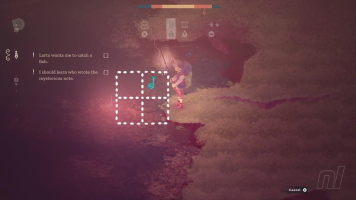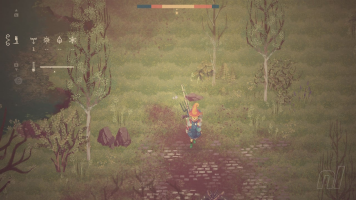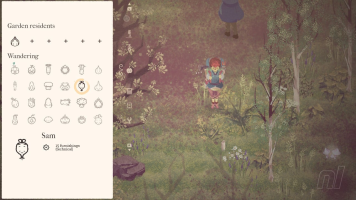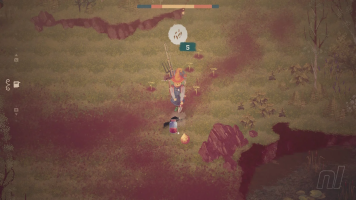Official Review
carrotcake's debut game, The Garden Path, fits this mantra to a tee. Solo developer and artist Louis Durrant started working on this passion project over seven years ago; upon planting the seeds for this entirely different slice-of-life sim, he worked to meticulously care for and nurture every single aspect of the game. From the art to the mechanics to the vibe, The Garden Path is the most accurate representation of gardening in a video game, and it's both the game's biggest strength and biggest weakness.
The Garden Path answers the age-old question: "What if Animal Crossing stopped to smell the roses once in a while?" Using shades of Nintendo's life sim and the feel of the Moomin comics, The Garden Path feels like a quirky British children's book from the '80s with beautiful watercolor visuals, amusing residents and travelers with vegetables for heads, and a love of tea.
The game appropriately starts in spring; each day in the garden follows your Switch's internal clock, a season lasts one week, and a year lasts 28 days. On day one, your character arrives at a large garden, overrun with overgrown plants, though it's more like a small woodland with rivers winding through the trees and foliage shading the whole landscape. All you have on you is a hatchet, a thermos full of tea, and a torn page, which is what led you to the garden.
We picked up one half of a broken pair of secateurs, spoke to a statue, and set off with the grass and leaves crunching under our shoes. We chopped down the odd tree on the way, picking up materials and not giving a care in the world about what we should do. Upon checking the map, we discovered three visitors were hanging around the garden: Augusts, the resident bear scout, helped fix our broken tool for us; Lars, the cozy yak, taught us how to fish; and Thom, a fellow garden lover, gave us a little hint about our torn page.
The Garden Path wants you to do your own thing and go at your own pace; there's a brief tutorial that teaches you how to focus – which allows you to select a plant to harvest and study – but the game, quite literally, throws you into the weeds. Some glowing bugs will appear to suggest which direction to go in, but oftentimes, these blend into the beautiful hand-drawn backgrounds and we didn't spot these until our fourth day of playing. In fact, for our first few days of play, rather than embracing the carefree and gentle nature of the game, we felt more than a little overwhelmed, especially were rewarded with twigs and weeds for tending to the garden or when we tried to read tutorials in-game.
For example, Tones are vital to harvesting useful items, but we happened to stumble across them. Certain tasks will reward you with tones, and everything you can harvest is affected by the tones you have. You're more likely to harvest some parsley if you have a particular type of tone, for instance. You can even increase tones temporarily by brewing and drinking tea. Even your body temperature affects the tones you can have on your or collect. The idea behind the mechanic is lovely, and we're sure discovering it should feel like a pleasant surprise, but instead, we wish we'd known about it sooner so we didn't have a pile of twigs and weeds weighing down our rucksack.
Luckily, your garden will attract visitors daily, some of whom will be looking to take that stuff off your hands. Every single item has different values assigned to them, such as 'unusual', 'rustic', or 'vintage', which comes into play when trading for new tools, seeds, clothes, and decorative items. The animal traders, for example, might have a wooden fence to trade for, but they want something with 'rustic' value in return. Like many other things in The Garden Path, getting the items with these specific values might take time, but luckily, traders will always return to the garden, and you'll always know whether they're visiting because the game tells you (and you can check the map).
The animals aren't the only visitors you'll meet, and just like in Animal Crossing, you can invite people to live permanently in the garden. All of these characters are beautifully drawn and utterly charming, fitting into the weird, magical world of the garden perfectly. These vegetable-like people will stay if you fulfill specific requirements for them, like growing certain types of trees or placing down 'shiny' furniture. And, once you convince them to stay, they'll ask you to carry out simple little tasks like gathering ginger roots for them.
Getting these residents to stay will take time – sometimes, a lot of time. Planting seeds and trees isn't an overnight process and depends on factors like soil quality and fertiliser. The Garden Path wants you to know what each plant likes intimately, and while it never punishes you for not knowing, things definitely go slower if you don't know. It's apt for the sleepy tone of the game, but if you're used to the hustle of games like Animal Crossing, where you always have to be doing something, it's a bit of a culture shock.
On Switch, that steady slice-of-life pace can unfortunately feel glacial thanks to a number of issues in the game. We were made aware of a few bugs before diving into the game, but there are various issues with controls and load times that harm the meticulous process of The Garden Path. To dig a hole, you have to hold 'Y' to focus, then press 'X' on an empty patch of grass, meaning we'd have to twist our thumb over our finger. When focusing on a group of plants at once, if we wanted to check our research progress, we had to completely exit the research pop-up and re-focus on the plants. The fishing minigame also suffers from input delay and vaguely explained mechanics. There are also load times and delays for almost everything – from booting up the game, opening our rucksack, and even looking at the map.
We've also experienced several glitches that prevented us from doing certain things. Sometimes, the map won't let us place down markers or even scroll through to find out who is visiting the garden (a patch has since been submitted for this issue). Occasionally, we couldn't use our spade or fishing rod for no apparent reason. We've even experienced a crash or two when opening up menus.
The Garden Path's meditative pace is perfect for the game it's trying to be, but you need to be aware before diving into it. As such, the game feels incredibly niche and requires a particular type of player. There are ways to speed up certain things — lolly sticks are given as rewards and you can use those to get free harvestables, and if you do manage to catch a fish, releasing them sends out a song which can change the time of day or spawn certain plants. We've only seen spring in-game so far, so we still have a lot to experience, but it's clear that a lot of love has gone into this. Whether you have that love and dedication to pour back into it will depend on you – but the Switch version might not be the place to accommodate that.
Conclusion
The Garden Path is a labor of love for both developer carrotcake and the player. It targets for a specific audience that is accepting of a slower pace and a soft, cozy vibe. Unfortunately, that meticulous, mellow life is both The Garden Path's selling point and its weakness, with vague directions, advice, and control issues on Switch weighing down the experience even more. The Garden Path may grow on you over time, but whether you have the patience for that will be the real test.





